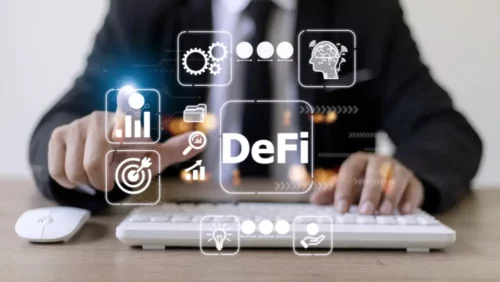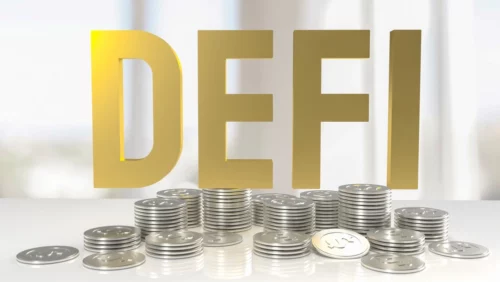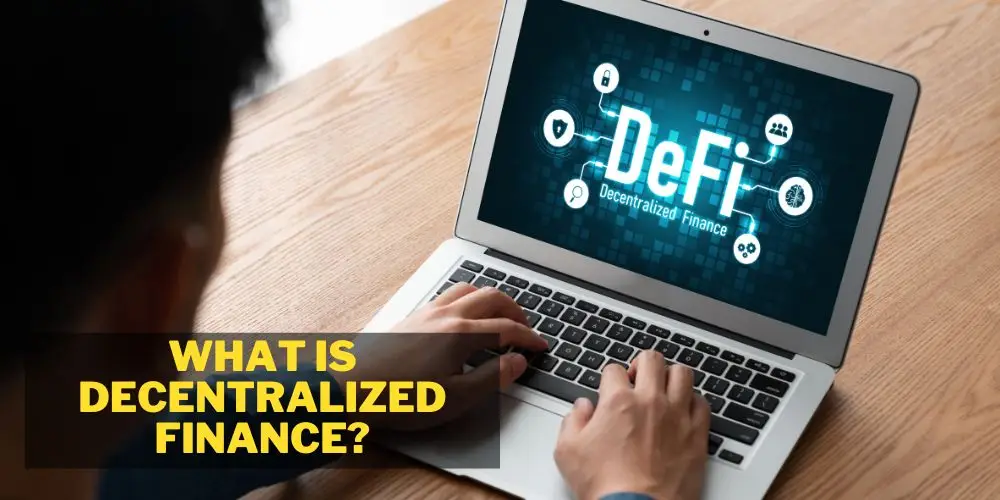Decentralized finance (DeFi) refers to a financial system built on blockchain technology. Unlike traditional financial systems that depend on intermediaries like banks and brokers, DeFi aims to remove the need for central authorities.
Instead, it uses blockchain networks, smart contracts, and cryptocurrencies to allow peer-to-peer financial transactions.
In this article, we will explore what DeFi is, how it works, its advantages, risks, and the potential future of decentralized finance.
What Is Decentralized Finance?
Blockchain Technology
The backbone of decentralized finance is blockchain technology. Blockchain is a distributed ledger that records transactions across multiple computers.
It is known for its security, transparency, and immutability. Once data is recorded, it cannot be altered, providing a high level of security. In DeFi, blockchain ensures that transactions are verified and processed without needing a central authority.
Most DeFi platforms are built on Ethereum, a blockchain that allows developers to create decentralized applications (dApps) and smart contracts.
Smart Contracts
Smart contracts are self-executing agreements where the terms of the contract are directly written into code. They automatically execute when predefined conditions are met.
For example, if a borrower repays a loan, the smart contract will automatically release the collateral.
In DeFi, smart contracts are used to remove the need for intermediaries, making transactions faster and more efficient. They also ensure transparency because the contract terms are accessible to all participants.
Cryptocurrencies
Cryptocurrencies like Ethereum (ETH), Bitcoin (BTC), and stablecoins are essential components of DeFi. They are used to conduct transactions, provide liquidity, and serve as collateral in DeFi lending and borrowing platforms.
Cryptocurrencies operate on decentralized networks, meaning no central authority controls their issuance or value. This aligns with the core principles of DeFi—creating a financial system independent of banks and other centralized institutions.
Decentralized Applications (dApps)
Decentralized applications, or dApps, are software applications that run on a blockchain network.
These applications enable users to interact with the DeFi ecosystem without relying on central entities. dApps are used for various purposes, such as lending, borrowing, trading, and investing.
Popular DeFi dApps include Aave for lending, Uniswap for decentralized trading, and Compound for lending and borrowing.
How Does DeFi Work?
DeFi operates on the principles of decentralization and trustlessness. In traditional finance, intermediaries like banks are responsible for validating transactions and ensuring trust.

In DeFi, transactions are validated through blockchain networks and smart contracts, eliminating the need for intermediaries. This makes DeFi a more open and transparent system.
Decentralization and Trustlessness
Decentralization means that power is distributed across a network rather than being controlled by a central authority. In DeFi, users interact directly with each other through smart contracts.
Trustlessness refers to the idea that participants do not need to trust any central authority. They only need to trust the code, which is open for anyone to audit. This makes DeFi more secure and transparent than traditional financial systems.
Examples of DeFi Platforms
DeFi platforms offer a variety of services, including lending, borrowing, trading, and investing. Aave and Compound are two popular lending platforms that allow users to earn interest by lending their cryptocurrency or borrow assets by providing collateral.
Uniswap, a decentralized exchange (DEX), allows users to trade cryptocurrencies directly with each other without relying on an intermediary.
These platforms operate using smart contracts and blockchain technology, ensuring security and transparency in all transactions.
Liquidity Pools
Liquidity pools are another important feature of DeFi platforms. A liquidity pool is a collection of cryptocurrencies provided by users to facilitate trading on decentralized exchanges.
Users who contribute liquidity to these pools earn fees in return. Liquidity pools enable decentralized exchanges like Uniswap to function, as they ensure that there is enough liquidity for users to trade tokens.
However, liquidity providers should be aware of risks such as impermanent loss, which occurs when the value of the tokens in a liquidity pool changes relative to one another.
Advantages of DeFi
DeFi offers several advantages over traditional finance, including transparency, security, accessibility, and lower costs.
Transparency
One of the main benefits of DeFi is its transparency. Blockchain technology records all transactions on a public ledger, meaning that anyone can view the details of any transaction.
Smart contracts are open-source, so users can verify the code to ensure that the platform is functioning as intended. This level of transparency is not typically found in traditional finance, where transactions are often opaque and controlled by central authorities.
Security
DeFi platforms are built on blockchain technology, which is known for its robust security features. Transactions are verified by the network, and once they are added to the blockchain, they cannot be changed.
The use of cryptography further ensures the safety of users’ funds. However, while the blockchain itself is secure, DeFi platforms can still be vulnerable to hacks if their smart contracts are poorly coded or if other security measures are not in place.
Inclusion and Accessibility
DeFi has the potential to bring financial services to people who are excluded from the traditional banking system. With just an internet connection, anyone can participate in DeFi, regardless of their location or financial status.
This opens up opportunities for the unbanked and underbanked populations to access financial tools such as loans, savings, and investments.
Reduced Costs
DeFi removes intermediaries, which means that users do not have to pay fees to banks, brokers, or other financial institutions.
Traditional financial systems often involve various fees for things like transferring money, making transactions, or holding accounts.
DeFi platforms, on the other hand, typically have lower fees and faster transaction times, making financial services more affordable.
Risks and Challenges of DeFi
Despite its many benefits, DeFi also comes with risks. These include smart contract vulnerabilities, security issues, regulatory uncertainty, and market volatility.

Smart Contract Vulnerabilities
While smart contracts are essential to DeFi, they are not without risk. If a smart contract contains a bug or flaw, it can be exploited by malicious actors.
In the past, there have been several high-profile incidents where hackers have taken advantage of vulnerabilities in DeFi platforms to steal funds. Regular audits and code reviews are important to ensure the safety and integrity of smart contracts.
Security Risks
Although blockchain technology is secure, DeFi platforms are still vulnerable to attacks. Hackers can exploit vulnerabilities in the platforms themselves or in the smart contracts that power them.
In addition, users must take precautions to protect their assets, such as using hardware wallets and enabling two-factor authentication.
Regulatory Uncertainty
DeFi is still a relatively new concept, and regulatory bodies are still figuring out how to govern decentralized finance. The lack of clear regulations makes it difficult for businesses and individuals to navigate the space.
Governments around the world are beginning to take notice, and future regulations could have a significant impact on the growth and adoption of DeFi.
Volatility
Cryptocurrencies are known for their price volatility, and DeFi is no exception. The value of tokens can fluctuate rapidly, making it difficult to predict the returns on investments.
This volatility can also affect the stability of DeFi platforms, especially those that rely on price-pegged assets.
Future of DeFi
The future of DeFi looks promising, but there are still challenges to overcome. As the DeFi ecosystem grows, developers are working on solutions to improve scalability, reduce fees, and enhance interoperability between different blockchain networks.
The rise of Layer 2 solutions, cross-chain compatibility, and other innovations will likely drive the next phase of DeFi’s growth.
In the future, we may also see more integration between DeFi and traditional finance. Some financial institutions are already experimenting with blockchain technology and decentralized systems.
As DeFi becomes more widely adopted, it could significantly disrupt traditional financial systems and create a more inclusive global economy.
However, for DeFi to reach its full potential, it must address issues like security, regulation, and user education. With continued development and innovation, DeFi could become an integral part of the future of finance.
Conclusion
Decentralized finance is a rapidly growing sector that offers transparency, security, and accessibility.
By removing intermediaries and leveraging blockchain technology, DeFi enables peer-to-peer financial transactions without the need for banks or other central authorities.
While DeFi offers many advantages, it also comes with risks, including smart contract vulnerabilities, security issues, and regulatory uncertainty.
As DeFi continues to evolve, it has the potential to reshape the financial industry and provide greater financial inclusion for people around the world. However, its success will depend on overcoming the challenges it faces and achieving broader adoption.


 Tags:
Tags:










